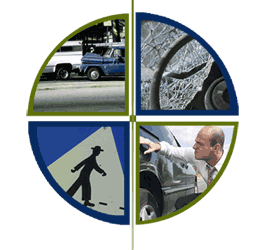
|
|
|
 |
 |
1200-C Agora Drive, #192
Bel Air, MD 21014-6865
Phone: 410.803.1310
Fax: 888.265.6660
Email: info@coverconsulting.com
|
|
|
 |
|
|
 |
High Speed Collisions
Many collisions occur at highway speeds. Cover Consulting has
investigated and reconstructed thousands of collisions that have
occurred at highway speeds. Our education, training and experience
has helped us in developing various methods in data collection and
the analytical evaluation of that data to assist us in determining
how the collision occurred.
Low Speed Collisions
Increased research in recent years indicates that the best way
to quantify the severity of low-speed collisions is in the terms of
Delta-v. Delta-v is the change in a vehicle's speed and direction
over the duration of an impact. When a vehicle experiences a change
in speed no greater that 8-10 miles per hour it is classified as a
low speed collision. Typically, there is little to no vehicle
damage. There have been a number of studies regarding the human
response to low speed front, rear and lateral collisions.
Researchers have used comparisons in low-speed vehicular impacts
with daily activities. Through direct graphical comparison,
researchers have quantified familiar activities using instrumented
human subjects that are analogous to the magnitude, direction and
duration of acceleration that are experienced in low-speed collisions.
Commercial Vehicle Collisions
An accurate investigation and reconstruction of commercial vehicle
collisions requires the analyst to be familiar with the mechanical
functions, vehicle behavior, performance and peculiarities of
commercial vehicles. Commercial vehicles fall under different state
and federal regulations than the common motor vehicle. Therefore,
commercial vehicle investigation and reconstruction requires the
collection of additional data and the application of different
analytical procedures than car-to-car collisions.
Motorcycle Collisions
Motorcycles have unique operational characteristics and capabilities.
Cover Consulting has been involved in hundreds of motorcycle collision
investigations and reconstructions. We have the education, training and
experience to properly collect the necessary data from the motorcycle and
the collision scene that is essential in determining the circumstances
relating to a motorcycle collision.
Pedestrian/Bicycle
Pedestrian- or bicycle-versus-vehicle collisions are less understood
than typical two car collisions. Collisions involving pedestrians or
bicycles generally produce little obvious physical evidence. The physical
evidence that is produced is often overlooked by those with an
untrained eye. However, those with advanced education, training and
experience can make a proper analysis of limited physical evidence
and determine the circumstance relating to a pedestrian/bicycle
versus vehicle collision.
Forensic Mapping
Cover Consulting uses the latest technology in electronic distance
measuring instruments, electronic data collectors and computer based
mapping software. The instruments allow us to efficiently and
accurately determine and document various types of distances used in
our collision scene analysis. The utilization of this technology has
greatly enhanced the investigation, reconstruction, mapping and the
presentation of our findings.
Photogrammetry
Vehicle crush measurements and the length of skidmarks are
important parts of determining the speeds of vehicles involved in
collisions. Photographs of damaged vehicles and the collision scenes
are often the only evidence available when the vehicles are no
longer available and skidmark evidence has dissipated. Unless
photographs are taken at right angles to the surface from which you
are attempting to extrapolate measurements, it can be difficult and
sometimes impossible to determine accurate dimensions from the
photographs because of photographic
distortion.
Photogrammetry is the science of extracting measurements from photographs.
Our analyst are trained in photogrammetric computer software to take advantage
of the information contained in your film-based or digital photographs and
create a three-dimensional model and images from which accurate
dimensions can be determined. Those dimensions can then be used to
calculate vehicle speeds from information that was previously unknown.
Demonstrative Evidence
It's been said repeatedly. "Seeing is believing". "A picture is worth
a thousand words". "Jurors remember 80% of what they see and 20% of what they
hear". Language is a wonderful and expressive tool, but sometimes it
lacks the ability to describe to a layperson the complexities of how
a collision did or did not occur. Demonstrative evidence creates
clear and powerful visually compelling evidence for depositions,
meditations and trials. With today's technology, we are able to
produce high quality and cost effective presentations that
simplifies and illustrates complex spatial relationships and
scientific principles.
|
|

|
